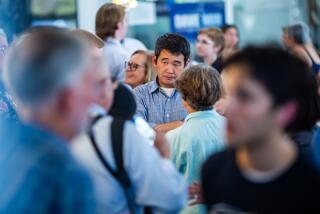CRIME AND THE FEAR FACTOR
When Sen. Pete Wilson opened his campaign for governor in February, his first speeches targeted a favorite GOP subject--crime. Those appearances in San Diego, Los Angeles, Alameda and Sacramento were greeted enthusiastically. Campaigning on the crime issue here would be a bit more problematic.
About nine in 10 county residents in the 1989 Orange County Annual Survey report they feel very or at least somewhat safe in their neighborhoods during the day. And two-thirds say the fear of crime never or rarely prevents them from doing things they want to do.
These views are not unanimous, though. Residents of the central portion of the county, for example, are less likely to say they feel safe. People who see crime as the most important public policy issue facing the county also feel less safe.
Some of these feelings obtain in the matter of fear of crime’s preventing free activity. Central county residents are more likely than those in other sections to say they are hindered in their activities. So are older residents and those in the lower income bracket. The perception of crime as the county’s most important problem also has an effect here.
This is not to say, though, that the issue of crime is completely without resonance here. True, it is the fourth-rated public policy problem, behind traffic, growth and housing. But the percentage mentioning crime has grown, increasing from 8% in 1988 to 12% last year.
This question was asked to gauge feelings of safety in county neighborhoods: “As far as your community is concerned, how safe do you feel walking around in your neighborhood during the day? Would you say you feel very safe, somewhat safe, somewhat unsafe or very unsafe?”
To determine how much fear of crime affects residents, this question was asked: “How often does fear of crime prevent you from doing things you would like to do--always, often, sometimes, rarely or never?”
Here are the results to both questions:
No Safe+ Unsafe++ Opinion TOTAL 92% 8% * AGE 18-34 years 90 9 1% 35-54 94 6 * 55 and older 93 7 * REGION+++ North 89 10 1 West 96 4 * Central 85 14 1 South 98 2 * HOUSEHOLD INCOME More than $50,000 97 3 * $36,000-$50,000 92 8 * Less than $36,000 89 11 * POLITICAL ORIENTATION Conservative 94 6 * Middle of the road 94 5 1 Liberal 89 11 * FEAR OF CRIME IS HINDRANCE Always/often 73 26 1 Sometimes 86 13 1 Rarely/never 98 2 * LIFE IN COUNTY IS GOING Well 94 6 * Badly 87 13 *
HOW MUCH FEAR IS A HINDRANCE
Rarely/ Often/ No Never Sometimes Always Opinion TOTAL 67% 22% 10% 1% AGE 18-34 years 66 24 9 1 35-54 70 22 7 1 55 and older 63 22 15 * REGION+++ North 63 25 11 1 West 71 22 7 * Central 58 27 14 1 South 77 16 6 1 HOUSEHOLD INCOME More than $50,000 78 17 4 1 $36,000-$50,000 63 27 10 * Less than $36,000 60 24 15 1 POLITICAL ORIENTATION Conservative 69 21 10 * Middle of the road 68 23 8 1 Liberal 66 25 9 * FEEL SAFE IN NEIGHBORHOOD Very/somewhat safe 71 21 8 * Somewhat/very unsafe 24 41 34 1 LIFE IN COUNTY IS GOING Well 70 21 8 1 Badly 55 28 16 1
* Less than 1%
+ “Very” or “somewhat” safe
++ “Somewhat” or “very” unsafe
+++North: Anaheim, Brea, Buena Park, Fullerton, La Habra, Orange, Placentia, Villa Park, Yorba Linda. Central: Costa Mesa, Garden Grove, Santa Ana, Tustin, Tustin Foothills. West: Cypress, Fountain Valley, Huntington Beach, La Palma, Los Alamitos, Midway City, Rossmoor, Stanton, Seal Beach, Westminster. South: Capistrano Beach, Dana Point, El Toro, Emerald Bay, Irvine, Laguna Beach, Laguna Hills, Laguna Niguel, Mission Viejo, Newport Beach, San Clemente, San Juan Capistrano, Silverado, South Laguna COUNTY’S MOST IMPORTANT POLICY ISSUE 1988 Traffic: 48% Population growth: 20% Housing: 10% Crime: 8% Quality of Schools: 5% Immigration: 5% All other: 4% 1989 Traffic: 40% Population growth: 17% Housing: 14% Crime: 12% Quality of Schools: 5% Immigration: 9% All other: 3% Source: Orange County Annual Survey by Mark Baldassare
More to Read
Get the L.A. Times Politics newsletter
Deeply reported insights into legislation, politics and policy from Sacramento, Washington and beyond. In your inbox three times per week.
You may occasionally receive promotional content from the Los Angeles Times.










